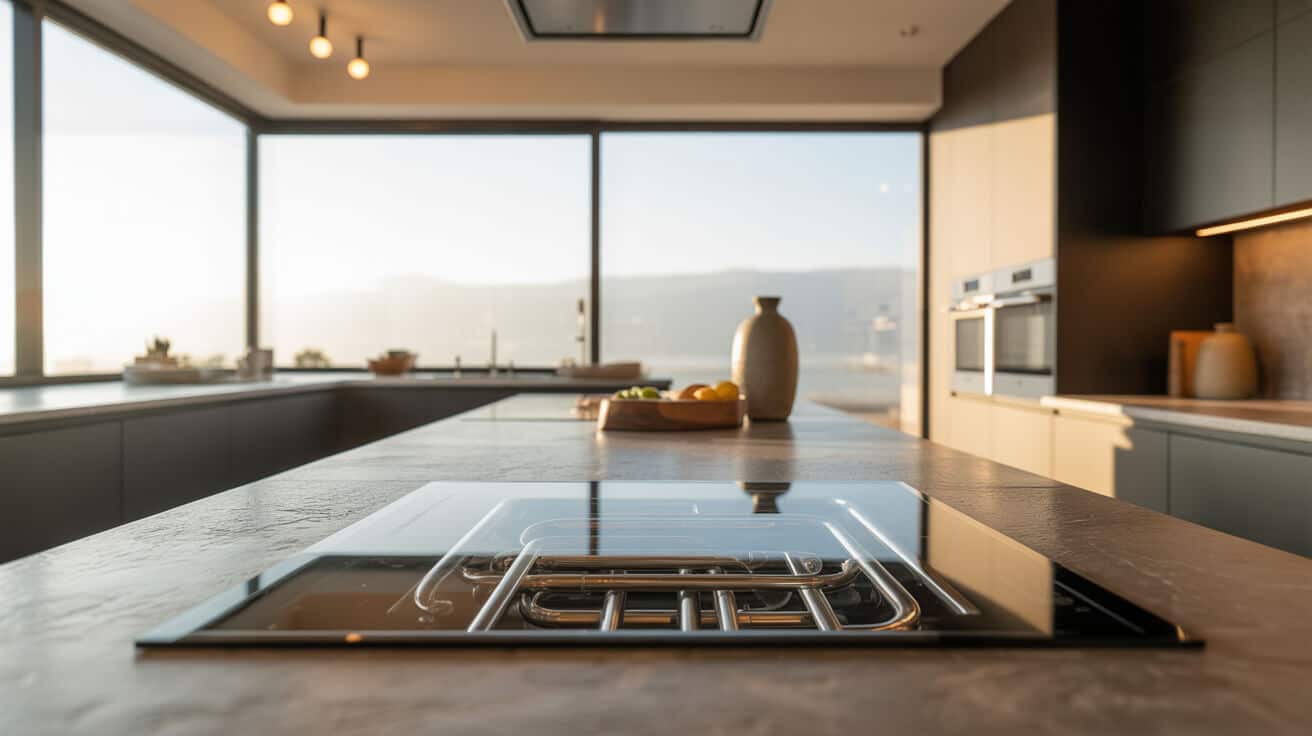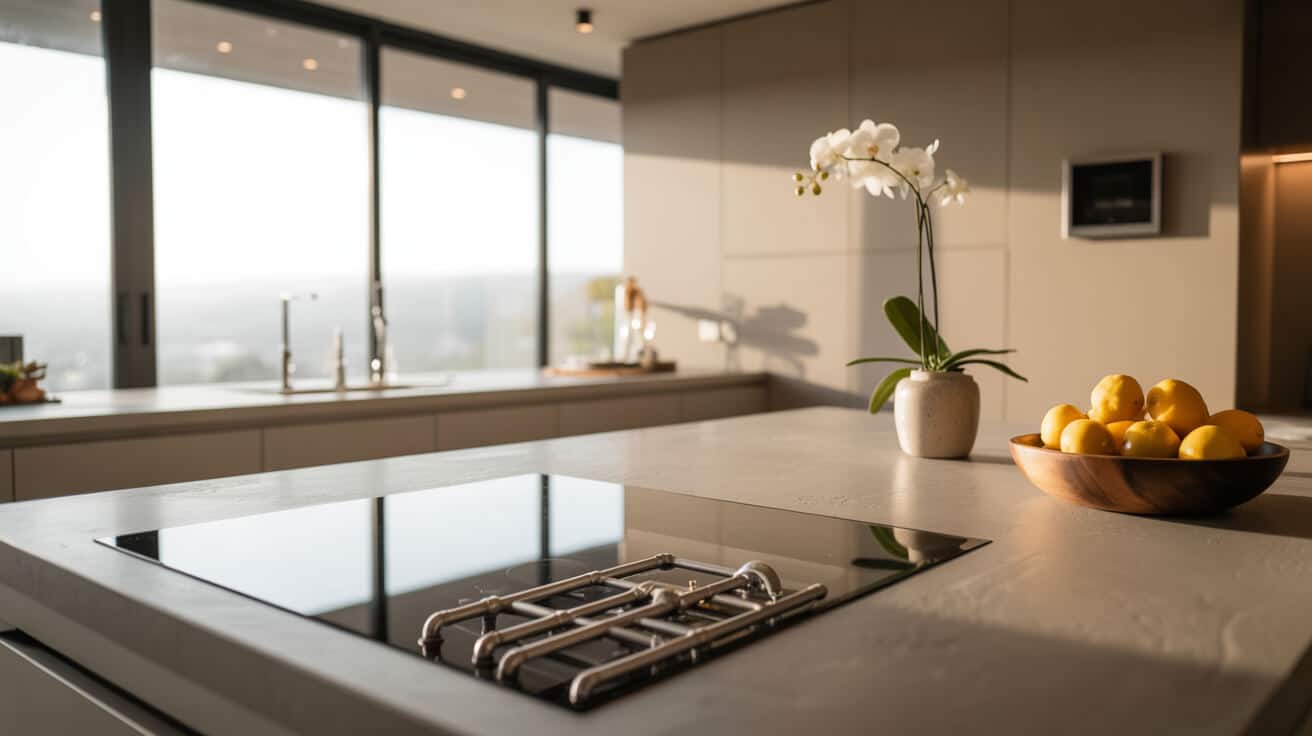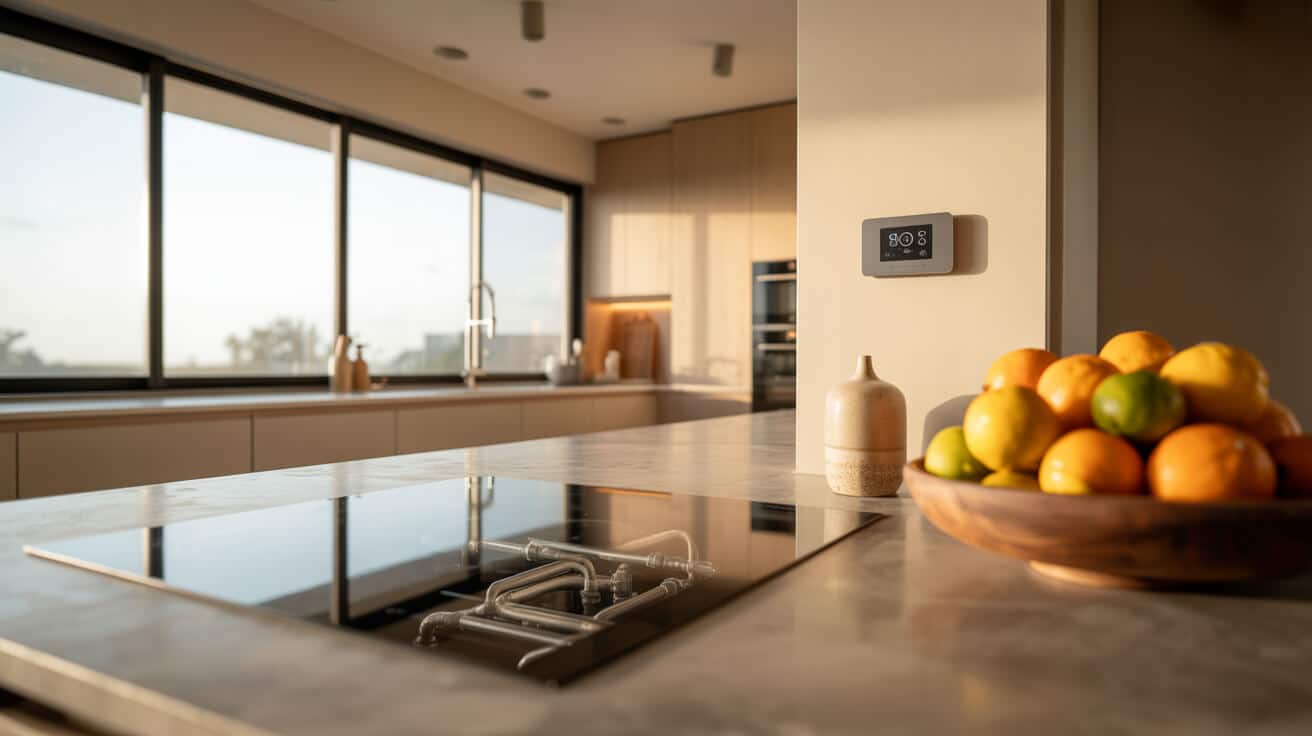Sophisticated in its engineering yet seamless in your everyday experience, Uponor underfloor heating moves beyond conventional radiators or air systems by utilising the principles of radiant floor heat. Pipes constructed from cross-linked polyethylene (PEX) or polyethylene of raised temperature resistance (PERT) are laid in calculated configurations and connected to a manifold, ensuring uniform temperature distribution in each zone of your property. The result is a heating solution that liberates your wall and floor space, supports flexible interior design, and aligns with evolving environmental standards. The modular controls, pioneered by platforms like Smatrix, adapt to your schedule and preferences, allowing energy savings without compromise on comfort.
Etymology or name origin
Uponor’s name is rooted in the Finnish language, reflecting a blend of tradition and innovation foundational to the company’s identity. The term “underfloor heating” describes the core concept of delivering heat through a system installed below your flooring, a notion that finds precedent in ancient civilizations yet is realised today with precise engineering and modern materials. The technical lexicon—terms like PEX, manifold, or Smatrix—reflects both the evolution of the materials science field and the growing sophistication of building controls relevant to your home or property.
Overview / context
Hydronic radiant heating in modern construction
Across the built environment, there is a pronounced trend toward solutions delivering both comfort and operational efficiency. Underfloor heating occupies a distinctive role as a surface-integrated heating method designed to address the limitations of convective heaters. Compared to radiators and forced-air systems that create thermal stratification and turbulent mixing of dust or allergens, sub-floor systems provide even, controllable, and noiseless warmth emanating evenly from the floor.
Uponor’s position and market landscape
Uponor has evolved from a regional pipe manufacturer into a global leader in plumbing and indoor climate solutions. Its underfloor heating products have reshaped the heating market by enabling integration with high-efficiency condensing boilers, ground and air-source heat pumps, and solar thermal sources. These systems are adopted by developers, property managers, and homeowners focused on design flexibility, energy performance, and regulatory compliance.
Regulatory setting and sectoral standards
In regions like the UK, hydronic radiant heating systems are governed by regulations such as BS EN 1264, which certifies thermal output, and Building Regulations (notably Part L and Part G), which define energy and water safety standards. From design calculations to component manufacture, the entire process aims to ensure systems are durable, effective, and aligned with environmental policies and your comfort needs.
History
Origins and ancient antecedents
The principle of heating a floor from below finds its roots in ancient Rome’s hypocaust system, a method that used channels beneath mosaic floors to circulate hot air. In East Asia, traditional Korean ondol systems similarly moved smoke or hot gases under stone floors to provide radiant warmth—a concept still valued for psychological comfort and health.
Modern industrial emergence
The twentieth century saw a paradigm shift as plastics engineering unlocked the possibility for safer, more flexible, and longer-lasting piping. Post-war Europe, fueled by oil crises and architectural innovation, embraced underfloor heating for residential and commercial energy security. The introduction of cross-linked polyethylene revolutionised hydronic infrastructure, overcoming corrosion and scaling issues that plagued metal alternatives.
Uponor’s role and sectoral adoption
Uponor’s entrance into radiant heating was marked by the fusion of material technology and hydronic system know-how, allowing the creation of reliable, pressure-resistant, and temperature-stable floor circuits. During the 1980s and 1990s, the company expanded from pipe manufacturing into offering fully engineered heating “systems,” including manifolds, controls, and smart zoning. National incentives and the drive for net-zero buildings widened adoption, with Plumbers 4U among those leading certified installation and aftercare.

Concept / description
Principles of hydronic floor heating
Uponor’s underfloor heating solution is based on circulating warm water through a network of pipes embedded within the flooring build-up. The water’s temperature is controlled via a mixing unit or manifold, ensuring each room receives heat matched to its specific requirements. Heat is released through the floor finish—tile, wood, stone, or carpet—and radiated upward, warming objects and occupants directly, and creating a gentle, enveloping comfort that is often imperceptible yet pervasive.
Piping and floor build-up
The backbone of the system consists of PEX or PERT pipes, selected for their flexibility, resistance to temperature cycling, and chemical inertness. These pipes are arranged in meandering (serpentine) or spiral patterns to optimise surface temperature uniformity. The layout is sandwiched between a layer of insulation—preventing downward heat loss—and a screed or dry panel which acts as the thermal mass and final heat emitter. In retrofits where floor height is limited, overlay boards permit ultra-low-profile installation.
Table: Uponor Underfloor Piping Options
| Pipe Type | Material | Max Temp (°C) | Max Pressure (Bar) | Application |
|---|---|---|---|---|
| PEX-a | Polyethylene | 95 | 6 | Standard/screed |
| MLCP | Multi-layer composite | 70 | 10 | Low-profile/joist |
| PERT | Polyethylene | 70 | 6 | Standard/overlay |
Manifolds and distribution
Manifolds are the control centre, allowing water to be distributed to multiple circuits/zones independently. Each manifold houses flow metres, balancing valves, thermostatic controls, and, in advanced installations, wireless actuators connected to room sensors. This modular approach allows for phased installation and finer adjustment in multi-use buildings.
Controls and zoning
Smatrix, Uponor’s flagship control system, offers a digital, multi-zone platform capable of integrating thermostats, occupancy sensors, mobile device interfaces, and self-learning algorithms. It supports both wired and wireless configurations, allowing your property’s floor heating to be tuned for differing occupation and comfort profiles. Plumbers 4U optimises system design to match your lifestyle and pattern of use.
Heat source integration
Design flexibility is a defining feature. You can connect the system to Condensing Boilers, air-source heat pumps, geothermal arrays, or even district heating. The low flow temperatures (often 35–45°C) exploited by underfloor heating maximise the efficiency of modern heat sources, promoting energy and cost savings for your property.
Functionality / purpose / applications
Properties and buildings served
Underfloor heating is used in a spectrum of projects, from new builds to retrofits, residential houses to large commercial sites such as schools, hospitals, hotels, and open-plan offices. For your property, it provides:
- Even warmth across rooms regardless of external conditions.
- Greater design freedom by eliminating conventional radiators.
- Health and air quality benefits due to the reduction in airborne dust and allergens.
Comfort advantage
Radiant floors create a unique comfort signature. By matching surface temperatures closely to skin temperature, underfloor systems avoid the cold draughts or overheating experienced with air or fan-coil devices. Occupants frequently report improved sleep and wellness, a “barefoot comfort” that is accessible and non-intrusive.
Energy and operational efficiency
Homeowners and facilities managers benefit from systems that use lower supply water temperatures, requiring less energy input for the same heating effect. When connected to a heat pump, efficiency rises and ongoing operational costs drop. Programmable controls further ensure that energy is used only when and where it is needed.
Service and maintenance
Yearly servicing carried out by your chosen professionals (such as Plumbers 4U) maintains long-term reliability. Checks include manifold operation, actuator cycling, controller calibration, pipe circuit flushing, and response time testing—a suite of measures that safeguard your investment and comfort.
Classifications / types / variants
Hydronic versus electric
Hydronic (water-based) systems dominate in large spaces and whole-home retrofits, prized for their efficiency at scale and ability to leverage renewable energy. Electric underfloor heating, although easier to retrofit in small or isolated rooms, remains less common due to running costs and limited output for large spaces.
System variants
Screed-based systems
Pipes are encased in a wet sand-cement screed, producing significant thermal inertia and consistent output ideal for new builds and large rooms.
Low-profile/overlay systems
Where floor depth is limited—such as in renovations or listed buildings—insulated, castellated panels accept piping above the old floor, enabling rapid instal with minimal disruption.
Joist/batten installations
In suspended timber floors, pipes rest in aluminium heat diffusion plates, tightly coupled to ensure heat is evenly radiated.
Controls ecosystem
Configurable for both wired and wireless platforms, from basic individual thermostats to integrated home-management suites, controls are central to enabling user comfort, scheduling, and energy performance. Smatrix controls uniquely automate flow balancing and enable scheduling from your mobile device.
Comparative table: Types of Underfloor Heating
| System | Emission Medium | Application | Floor Build-up | Response Time | Controls |
|---|---|---|---|---|---|
| Hydronic | Water | Whole property | Variable | Moderate | Wired/wireless |
| Electric | Resistive wire | Small rooms | Ultra-thin | Fast | Wired only |
| Low-profile | Water | Retrofit | Minimal | Fast | Wired/wireless |
Systems / tools / methodologies
Essential installation tools
- Pipe cutters: For precise sizing and edge integrity.
- Pipe straighteners/uncoilers: To lay long loops efficiently.
- Press fitting tools: Ensuring leak-proof joints at manifold connections.
- Thermal imaging: For quality assurance and identifying cold spots post-instal.
- Pressure test pumps: To validate loop integrity before screeding.
- Flow metres & balancing valves: For commissioning each circuit.
Engineering and system design
Proper heat loss calculations are performed to size every room circuit, accounting for insulation, window area, and occupancy. Your installer will select the optimal pipe spacing and layout (serpentine or spiral) based on this data.
Commissioning best practice
After installation, water is cycled, pressure tested, and flow rates are balanced. Controls are calibrated and user instruction is provided. Plumbers 4U ensures all data is logged for future maintenance and regulatory documentation.
Table: Key Installation Methodologies by Property Type
| Project Type | Preferred System | Core Challenges | Key Tools |
|---|---|---|---|
| New Build | Screed-based | Design integration | Pipe layout grid, balancing |
| Apartment Retrofit | Low-profile overlay | Height constraint | Overlay panels, dry-fit |
| Heritage | Joist/batten | Restricted works | Heat plates, joist guides |
| Commercial | Multi-zone hydronic | Complex zoning, BMS link | Smatrix, manifold arrays |

Stakeholders / entities involved
Certified installers and specifiers
Your property gains from solutions installed by Plumbers 4U and similarly qualified professionals holding accreditations such as G3 (unvented systems), WRAS (water regulations), and MCS (renewable integration).
Architects and property managers
Early integration with project architects ensures the system complements room layout and performance goals. For landlords or facility managers, underfloor heating streamlines maintenance by reducing the number of visible components prone to tampering or damage.
Manufacturers, suppliers, and industry bodies
Beyond Uponor, sectoral players such as Polypipe, Nu-Heat, and John Guest Speedfit contribute proprietary and standardised system components. Industry associations like CIPHE (Chartered Institute of Plumbing and Heating Engineering) help set standards and influence compliance and quality monitoring.
Occupants and maintenance personnel
Enjoyment of heating and system longevity is reinforced by clear, routine handover documentation and scheduled aftercare. For larger sites, a maintenance contract with a certified provider such as Plumbers 4U reduces the risk of service disruption and ensures compliance.
Legal / regulatory / ethical considerations
Building regulations and product approval
Your installation should align with:
- Part L: (Energy) – defines minimum efficiency for new systems.
- Part G: (Sanitation) – ensures water safety, especially where heating and potable supply intersect.
- Part P: (Electrical) – covers safety of control wiring in bathrooms and kitchens.
- BS EN 1264: – details design and safety for hydronic heating.
Certification and compliance
Products installed must carry WRAS approval to guarantee water safety. G3 qualification is required for all engineers working on unvented heating. MCS and similar certifications allow connection to government-backed renewable incentive schemes.
Documentation and user protection
Plumbers 4U provides commissioning records, maintenance logs, and user guides, empowering you with evidence for insurers, building control, and future owners. These records also assist with warranty claims and aftercare.
Ethical and environmental obligations
Your system design should consider lifecycle carbon impact, material recyclability, and responsible recycling or disposal at end-of-life. Professional recommendations align with both legal and environmental best practice.
Performance metrics / data / measurements
Efficiency and thermal output
- Heat output: is typically 55–90 W/m², dictated by supply temperature and floor construction.
- Annual energy consumption: is reduced by enabling lower supply temperatures (as low as 35°C for condensing boilers or heat pumps).
- Control precision: through Smatrix enables zone-by-zone reduction in energy use when spaces are unoccupied.
Impact on building performance ratings
Properly designed underfloor heating systems enhance your property’s SAP rating and, ultimately, its EPC (Energy Performance Certificate) outcome. Integration with renewables further improves these indices.
Table: Typical Outputs and Performance Metrics
| Floor Type | Output (W/m²) | Supply Temp (°C) | Response Time | EPC/SAP Impact |
|---|---|---|---|---|
| Screed (new build) | 70–90 | 35–50 | Moderate | High |
| Overlay (retrofit) | 60–75 | 40–55 | Fast | Medium–High |
| Timber/Joist Floors | 55–70 | 45–60 | Moderate | Medium |
Service intervals and durability benchmarks
Routine service is typically annual, in line with recommendations from system providers such as Plumbers 4U. Pipes are rated for several decades, while manifolds, controls, and actuators benefit from regular cycling and cleaning.
Challenges / barriers / limitations
Technical and operational constraints
- Pipe layout complexity: can extend installation times and requires thorough planning to avoid cold spots or inadequate coverage.
- Balancing and commissioning: are critical for large or multi-zone properties and must be performed by experienced installers.
- Airlocks or flow restrictions: may occur if maintenance lapses, manifesting as uneven heat or reduced performance.
- Limited access for repairs: post-installation; remediation, if required, can be invasive.
Economic and retrofit limitations
- Upfront cost: is higher than that for traditional radiators, particularly in retrofits where subfloor access is restricted.
- Floor height considerations: Overlay systems mitigate but don’t eliminate this concern, which can be especially acute in older buildings.
- Market knowledge: Landlords and facility managers sometimes hesitate due to unfamiliarity with system advantages or perceived complexity, although professional advice and transparent documentation from your provider can bridge this gap.
Service and user experience risks
Under-maintained systems can accumulate debris or encounter electronic faults; establishing a service plan with a specialist such as Plumbers 4U is essential for long-term satisfaction. User education regarding control settings and seasonal adjustments reduces performance complaints.
Impact / influence / legacy
Architectural freedom and property value
Underfloor heating unlocks layout fluidity, supporting modern open-plan conventions and minimalistic décor. Removal of radiators or wall-mounted devices increases net usable space and facilitates barrier-free access.
Health and comfort indices
A gentle, even heat profile reduces airborne particles and draught-driven discomfort, supporting better respiratory health and well-being for your occupants.
Professional and industry development
The sector’s maturation is evident in installer specialisation, improved training standards, and ongoing advances in controls and integration—all areas fostered by major manufacturers and progressive installation partners like Plumbers 4U.
Legacy and sectoral role
Uponor’s innovation, from robust piping to digital controls, informs industry best practice and public procurement processes. The expectation of documented aftercare and guaranteed performance is now embodied in the service scripts of leading contractors.
Future directions, cultural relevance, and design discourse
Trends in smart controls and energy coupling
Advanced, self-optimising controls continue to improve user experience, learning your usage patterns to maximise comfort and savings while adapting to shifts in energy tariffs or heat source operation. Predictive diagnostics and remote monitoring are anticipated features.
Regulatory drivers and environmental mandates
National and regional energy policies are accelerating the shift to low-carbon, low-temperature systems. Future Homes Standard and similar frameworks envision radiant systems as integral to achieving new performance baselines in both residential and non-domestic building stock.
Social and aesthetic evolution
Heating solutions are increasingly valued for both their invisibility and the contribution they make to interior space and occupational health. As professional and lay discourse moves toward “wellness” and “user-centred” environments, underfloor heating’s appeal grows across demographics.
Skills, service, and sector resilience
The integration of increasingly digital, multi-platform heating solutions showcases the expanding responsibilities of your installation and service partners. Comprehensive support, intelligent aftercare, and continuous training are central pillars of future sector resilience, roles fulfilled by trusted providers such as Plumbers 4U.

